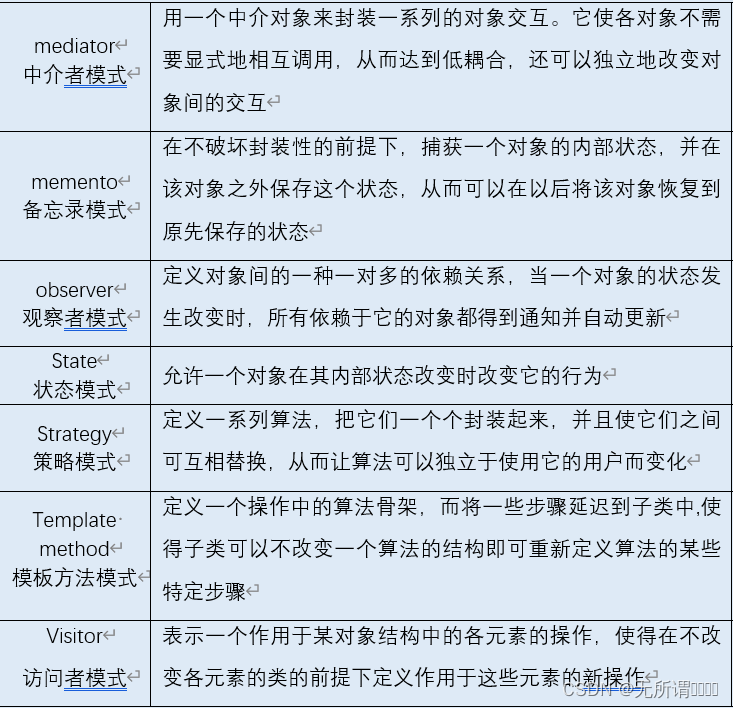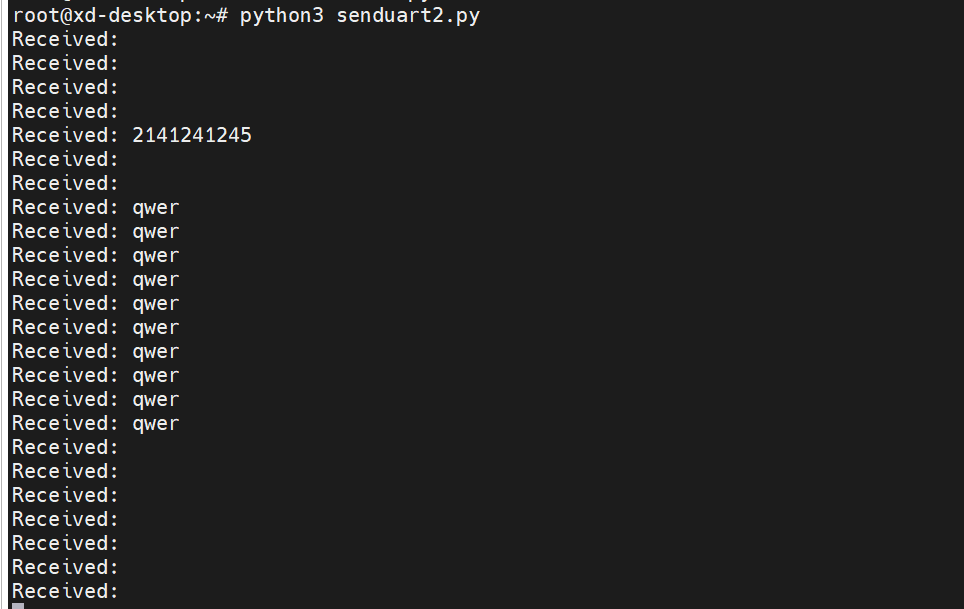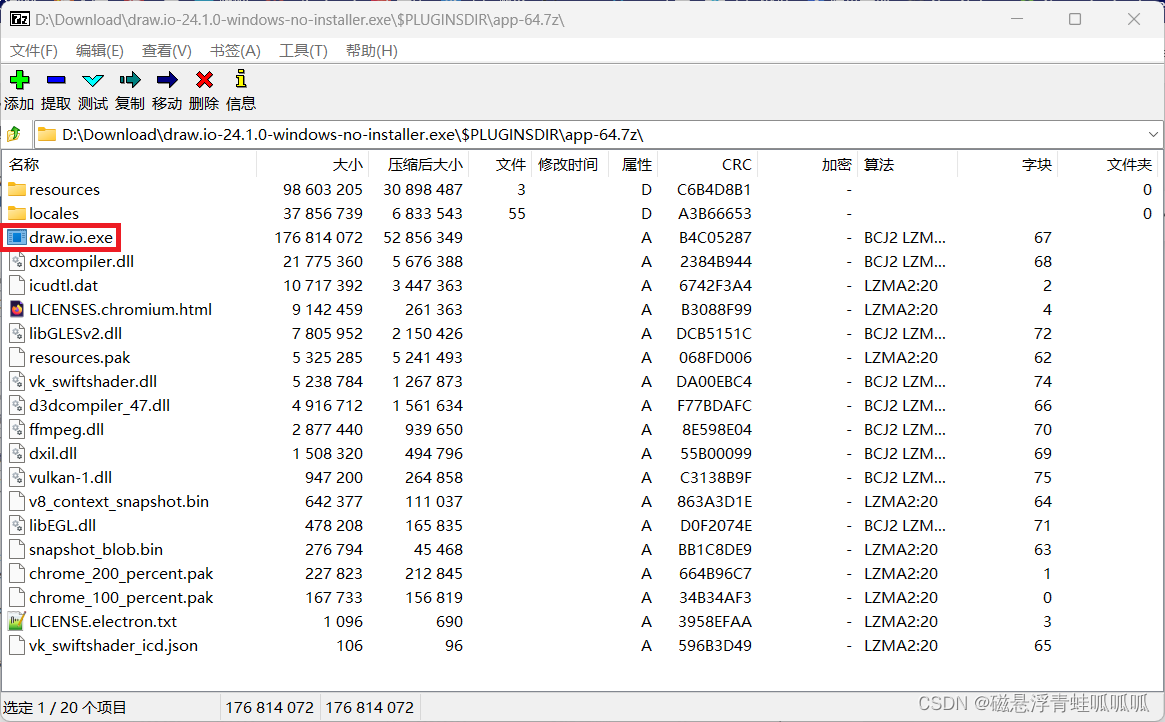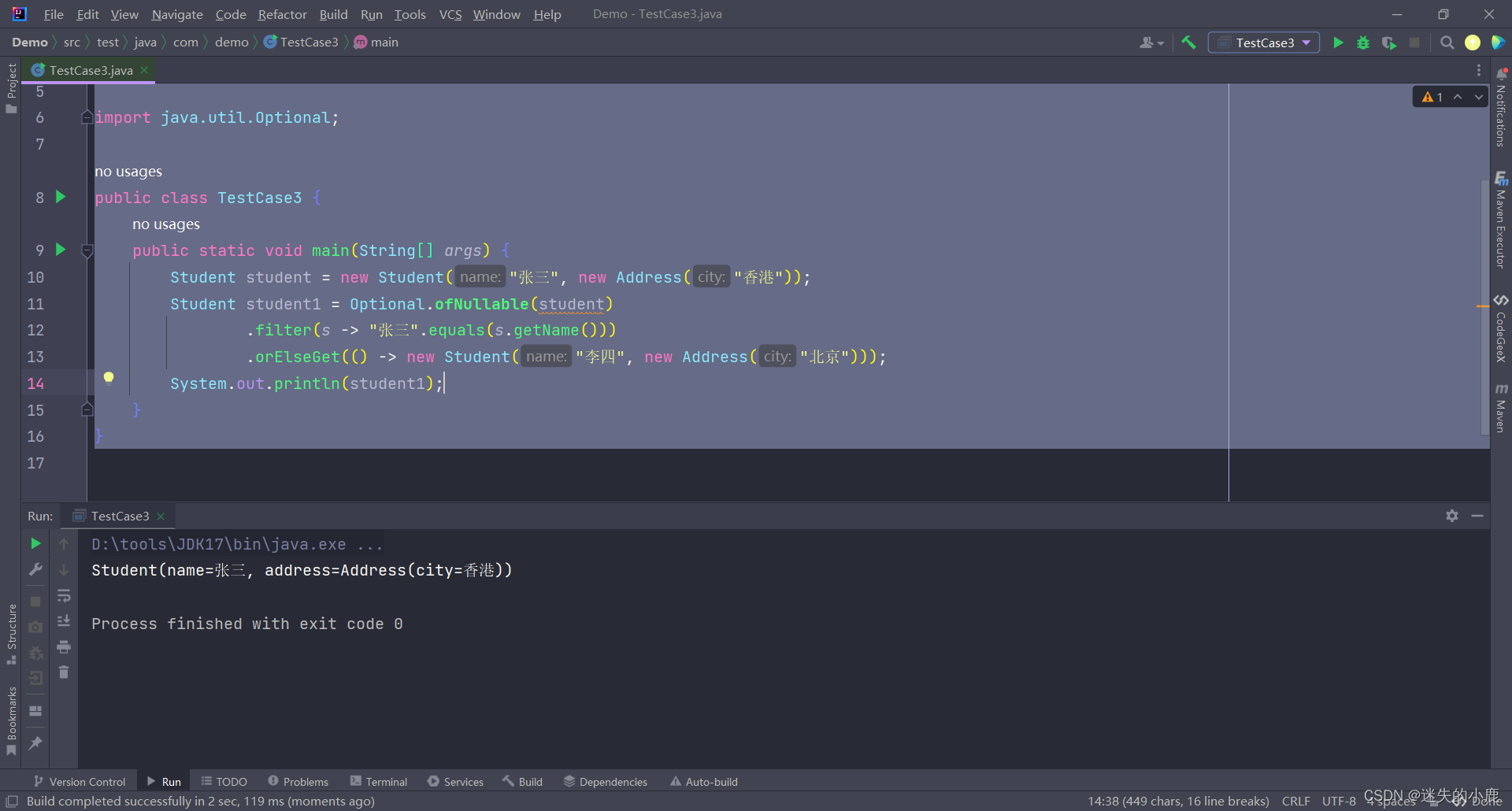二、贪心算法之区间调度问题
0.计算一个区间集合中无重复的区间的最大数量(模板)
public int intervalSchedule(int[][] intvs) {
if (intvs.length == 0) return 0;
// 按 end 升序排序
Arrays.sort(intvs, (a, b) -> Integer.compare(a[1], b[1]));
// 至少有一个区间不相交
int count = 1;
// 排序后,第一个区间就是 x
int x_end = intvs[0][1];
for (int[] interval : intvs) {
int start = interval[0];
if (start >= x_end) {
// 找到下一个选择的区间了
count++;
x_end = interval[1];
}
}
return count;
}
1.435无重叠区间
class Solution {
public int eraseOverlapIntervals(int[][] intervals) {
int n = intervals.length;
if (n == 0) return 0;
// 按 end 升序排序
Arrays.sort(intervals, (a, b) -> Integer.compare(a[1], b[1]));
// 至少有一个区间不相交
int count = 1;
// 排序后,第一个区间就是 x
int x_end = intervals[0][1];
for (int[] interval : intervals) {
int start = interval[0];
if (start >= x_end) {
// 找到下一个选择的区间了
count++;
x_end = interval[1];
}
}
//count为最多的互不相交的区间,n - count就为最少的需要去除的区间数量
count = n - count;
return count;
}
}
2.452.用最少的箭射爆气球
与模板不同点是在 intervalSchedule 算法中,如果两个区间的边界触碰,不算重叠;而按照这道题目的描述,箭头如果碰到气球的边界气球也会爆炸,所以说相当于区间的边界触碰也算重叠
将不重叠区间的条件 从 >= 改为 > 即可
class Solution {
public int findMinArrowShots(int[][] points) {
if (points.length == 0) return 0;
// 按 end 升序排序
Arrays.sort(points, (a, b) -> Integer.compare(a[1], b[1]));
// 至少有一个区间不相交
int count = 1;
// 排序后,第一个区间就是 x
int x_end = points[0][1];
for (int[] interval : points) {
int start = interval[0];
if (start > x_end) {
// 找到下一个选择的区间了
count++;
x_end = interval[1];
}
}
return count;
}
}
三、一个方法解决三道区间题

1.区间覆盖问题
1288删除被覆盖区间,返回剩余区间的数量
int removeCoveredIntervals(int[][] intvs) {
// 按照起点升序排列,起点相同时降序排列
Arrays.sort(intvs, (a, b) -> {
if (a[0] == b[0]) {
return b[1] - a[1];
}
return a[0] - b[0];
});
// 记录合并区间的起点和终点
int left = intvs[0][0];
int right = intvs[0][1];
int res = 0;
for (int i = 1; i < intvs.length; i++) {
int[] intv = intvs[i];
// 情况一,找到覆盖区间
if (left <= intv[0] && right >= intv[1]) {
res++;
}
// 情况二,找到相交区间,合并
if (right >= intv[0] && right <= intv[1]) {
right = intv[1];
}
// 情况三,完全不相交,更新起点和终点
if (right < intv[0]) {
left = intv[0];
right = intv[1];
}
}
//总数量减去合并后剩余的区间数量就是被删除的区间数量
return intvs.length - res;
}
2.区间合并问题
class Solution {
public int[][] merge(int[][] intervals) {
if(intervals == null || intervals.length == 0) return new int[][]{};
// 按区间的 start 升序排列
Arrays.sort(intervals, Comparator.comparingInt(a -> a[0]));
List<int[]> res = new ArrayList<>();
//将第一个元素加入到res中
res.add(intervals[0]);
// 注意从1开始
for(int i=1; i<intervals.length; i++){
int[] curr = intervals[i];
// res 中最后一个元素的引用
int[] last = res.get(res.size()-1);
if(curr[0] <= last[1]){ //当前的起始 < 上一个结束,表示相交
// 找到最大的 end
last[1] = Math.max(last[1], curr[1]);
} else{ //否则不相交
// 处理下一个待合并区间
res.add(curr);
}
}
return res.toArray(new int[res.size()][]);
}
}
3.区间交集问题
三个关键点
- 两区间相交的条件
- 获取相交区间的左端点和右端点
- 两个指针什么情况下移动
class Solution {
public int[][] intervalIntersection(int[][] firstList, int[][] secondList) {
int i = 0, j = 0;
List<int[]> res = new ArrayList<>();
while (i < firstList.length && j < secondList.length) {
//a1,b1 是 两个区间列表的左端点,a2,b2是对应的右端点
int a1 = firstList[i][0], a2 = firstList[i][1];
int b1 = secondList[j][0], b2 = secondList[j][1];
// 两个区间存在交集,使用没有交集的对立条件推出存在交集的条件
//if b2 < a1 or a2 < b1: [a1,a2] 和 [b1,b2] 无交集
if (b2 >= a1 && a2 >= b1) {
// 计算出交集,加入 res; 交集是左端点的最大值和右端点的最小值组成的
res.add(new int[]{Math.max(a1, b1), Math.min(a2, b2)});
}
// 指针前进,取决于右端点的大小,谁小谁就向后遍历
if (b2 < a2) {
j++;
} else {
i++;
}
}
return res.toArray(new int[res.size()][]);
}
}
四、LRU缓存 && LFU缓存
这个算是我老朋友了,我窥觊它得一个月了,但实在太难,直到遇见labuladong,学的更轻松了,也算是激发了我学习热情,感谢dong哥
LRU 算法的核心数据结构是使用哈希链表 LinkedHashMap,首先借助链表的有序性使得链表元素维持插入顺序,同时借助哈希映射的快速访问能力使得我们可以在 O(1) 时间访问链表的任意元素
1.LRU缓存
-
使用哈希双端链表(Java中对应的是LinkedHashMap)
-
创建Node单个节点 -> 组成DoubleList双端链表
-
因为同时维护map的双端链表,需要抽象出来几个方法在对元素操作时同时操作map和DoubleList,防止漏掉操作,比如说删除某个
key时,在cache中删除了对应的Node,但是却忘记在map中删除key。解决这种问题的有效方法是:在这两种数据结构之上提供一层抽象 API。
说的有点玄幻,实际上很简单,就是尽量让 ==LRU 的主方法
get和put避免直接操作map和cache==的细节。我们可以先实现下面几个函数: -
get逻辑比较简单,这里阐述一下put的逻辑
- 若key已经存在,那么修改key对应的value
- 若key不存在,需要插入key
- 当容量满的时候,淘汰最久未使用的key
- 当容量没有满,直接执行c
- 插入key和val为最近使用的数据
class LRUCache {
// key -> Node(key, val)
private HashMap<Integer, Node> map;
// Node(k1, v1) <-> Node(k2, v2)...
private DoubleList cache;
// 最大容量
private int cap;
public LRUCache(int capacity) {
this.cap = capacity;
map = new HashMap<>();
cache = new DoubleList();
}
class Node {
public int key, val;
public Node next, prev;
public Node(int k, int v) {
this.key = k;
this.val = v;
}
}
class DoubleList {
// 头尾虚节点
private Node head, tail;
// 链表元素数
private int size;
public DoubleList() {
// 初始化双向链表的数据
head = new Node(0, 0);
tail = new Node(0, 0);
head.next = tail;
tail.prev = head;
size = 0;
}
// 在链表尾部添加节点 x,时间 O(1)
public void addLast(Node x) {
x.prev = tail.prev;
x.next = tail;
tail.prev.next = x;
tail.prev = x;
size++;
}
// 删除链表中的 x 节点(x 一定存在)
// 由于是双链表且给的是目标 Node 节点,时间 O(1)
public void remove(Node x) {
x.prev.next = x.next;
x.next.prev = x.prev;
size--;
}
// 删除链表中第一个节点,并返回该节点,时间 O(1)
public Node removeFirst() {
if (head.next == tail)
return null;
Node first = head.next;
remove(first);
return first;
}
// 返回链表长度,时间 O(1)
public int size() { return size; }
}
/* 将某个 key 提升为最近使用的 */
private void makeRecently(int key) {
Node x = map.get(key);
// 先从链表中删除这个节点
cache.remove(x);
// 重新插到队尾
cache.addLast(x);
}
/* 添加最近使用的元素 */
private void addRecently(int key, int val) {
Node x = new Node(key, val);
// 链表尾部就是最近使用的元素
cache.addLast(x);
// 别忘了在 map 中添加 key 的映射
map.put(key, x);
}
/* 删除某一个 key */
private void deleteKey(int key) {
Node x = map.get(key);
// 从链表中删除
cache.remove(x);
// 从 map 中删除
map.remove(key);
}
/* 删除最久未使用的元素 */
private void removeLeastRecently() {
// 链表头部的第一个元素就是最久未使用的
Node deletedNode = cache.removeFirst();
// 同时别忘了从 map 中删除它的 key
int deletedKey = deletedNode.key;
map.remove(deletedKey);
}
public int get(int key) {
if (!map.containsKey(key)) {
return -1;
}
// 将该数据提升为最近使用的
makeRecently(key);
return map.get(key).val;
}
public void put(int key, int val) {
if (map.containsKey(key)) {
// 删除旧的数据
deleteKey(key);
// 新插入的数据为最近使用的数据
addRecently(key, val);
return;
}
if (cap == cache.size()) {
// 删除最久未使用的元素
removeLeastRecently();
}
// 添加为最近使用的元素
addRecently(key, val);
}
}
/**
* Your LRUCache object will be instantiated and called as such:
* LRUCache obj = new LRUCache(capacity);
* int param_1 = obj.get(key);
* obj.put(key,value);
*/
2.LFU缓存
class LFUCache {
// key 到 val 的映射,我们后文称为 KV 表
HashMap<Integer, Integer> keyToVal;
// key 到 freq 的映射,我们后文称为 KF 表
HashMap<Integer, Integer> keyToFreq;
// freq 到 key 列表的映射,我们后文称为 FK 表
HashMap<Integer, LinkedHashSet<Integer>> freqToKeys;
// 记录最小的频次
int minFreq;
// 记录 LFU 缓存的最大容量
int cap;
public LFUCache(int capacity) {
keyToVal = new HashMap<>();
keyToFreq = new HashMap<>();
freqToKeys = new HashMap<>();
this.cap = capacity;
this.minFreq = 0;
}
public int get(int key) {
if (!keyToVal.containsKey(key)) {
return -1;
}
// 增加 key 对应的 freq
increaseFreq(key);
return keyToVal.get(key);
}
public void put(int key, int val) {
if (this.cap <= 0) return;
/* 若 key 已存在,修改对应的 val 即可 */
if (keyToVal.containsKey(key)) {
keyToVal.put(key, val);
// key 对应的 freq 加一
increaseFreq(key);
return;
}
/* key 不存在,需要插入 */
/* 容量已满的话需要淘汰一个 freq 最小的 key */
if (this.cap <= keyToVal.size()) {
removeMinFreqKey();
}
/* 插入 key 和 val,对应的 freq 为 1 */
// 插入 KV 表
keyToVal.put(key, val);
// 插入 KF 表
keyToFreq.put(key, 1);
// 插入 FK 表
freqToKeys.putIfAbsent(1, new LinkedHashSet<>());
freqToKeys.get(1).add(key);
// 插入新 key 后最小的 freq 肯定是 1
this.minFreq = 1;
}
private void removeMinFreqKey() {
// freq 最小的 key 列表
LinkedHashSet<Integer> keyList = freqToKeys.get(this.minFreq);
// 其中最先被插入的那个 key 就是该被淘汰的 key
int deletedKey = keyList.iterator().next();
/* 更新 FK 表 */
keyList.remove(deletedKey);
if (keyList.isEmpty()) {
freqToKeys.remove(this.minFreq);
// 问:这里需要更新 minFreq 的值吗?
}
/* 更新 KV 表 */
keyToVal.remove(deletedKey);
/* 更新 KF 表 */
keyToFreq.remove(deletedKey);
}
private void increaseFreq(int key) {
int freq = keyToFreq.get(key);
/* 更新 KF 表 */
keyToFreq.put(key, freq + 1);
/* 更新 FK 表 */
// 将 key 从 freq 对应的列表中删除
freqToKeys.get(freq).remove(key);
// 将 key 加入 freq + 1 对应的列表中
freqToKeys.putIfAbsent(freq + 1, new LinkedHashSet<>());
freqToKeys.get(freq + 1).add(key);
// 如果 freq 对应的列表空了,移除这个 freq
if (freqToKeys.get(freq).isEmpty()) {
freqToKeys.remove(freq);
// 如果这个 freq 恰好是 minFreq,更新 minFreq
if (freq == this.minFreq) {
this.minFreq++;
}
}
}
}
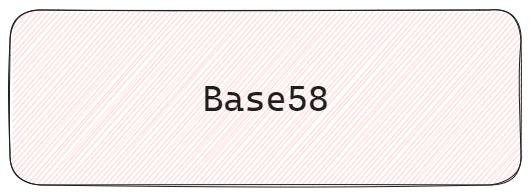

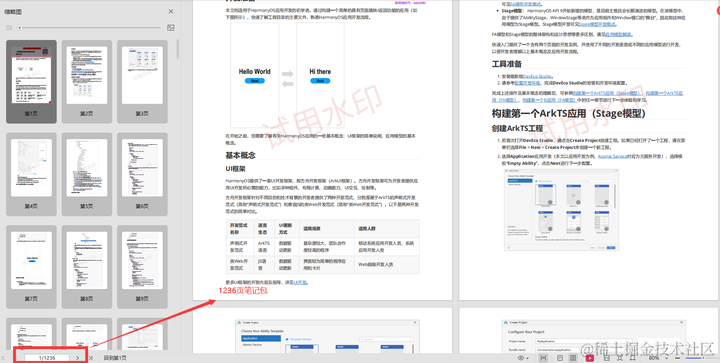

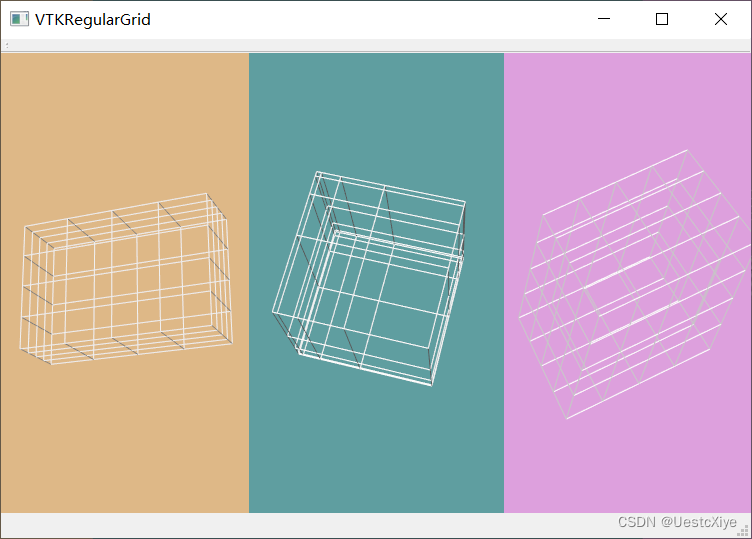

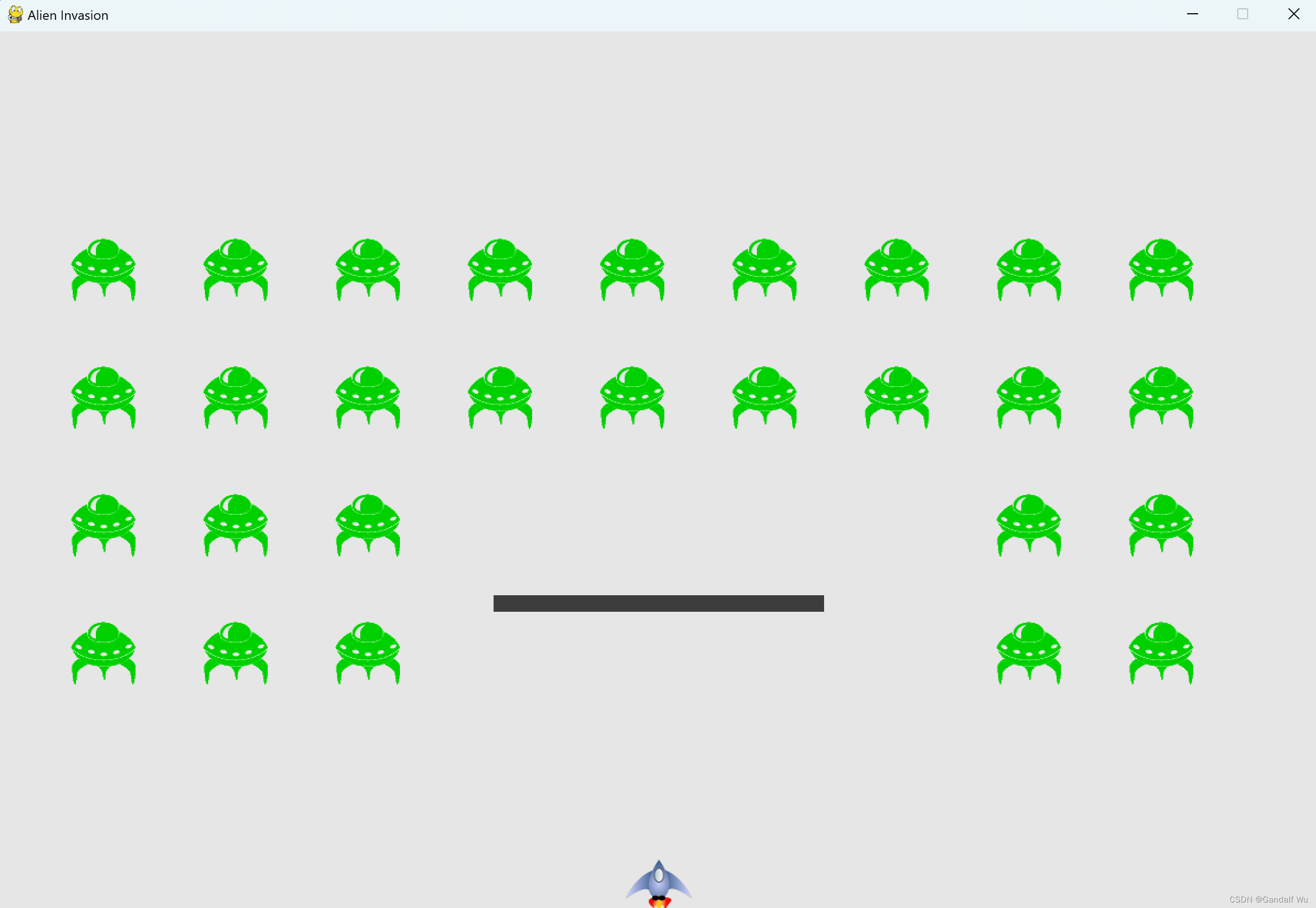

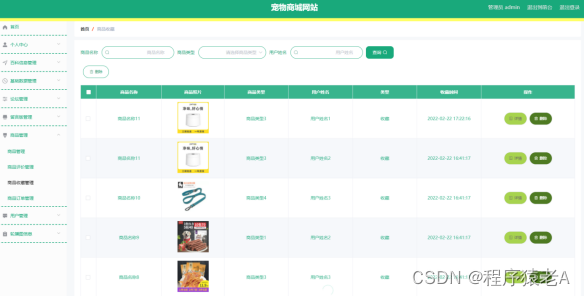
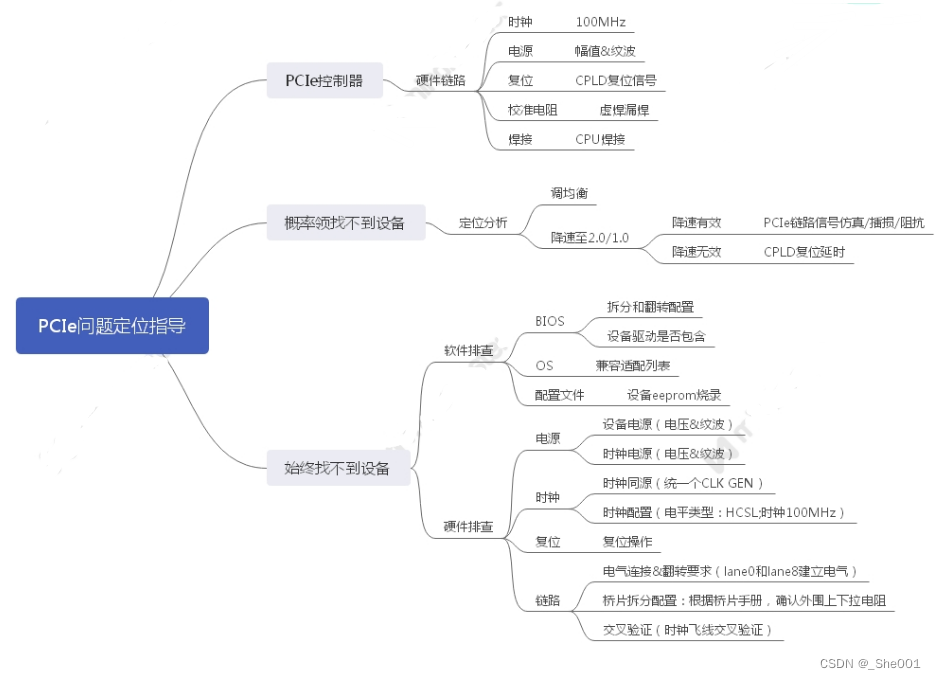
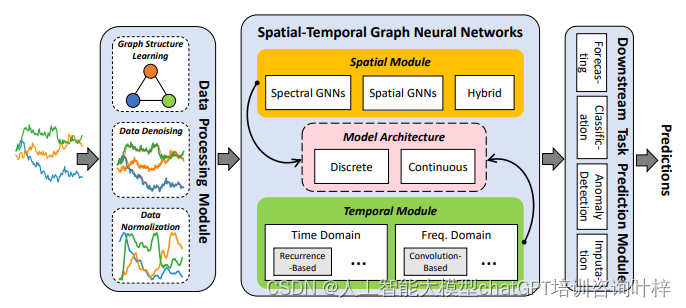
![[嵌入式系统-73]:RT-Thread-快速上手:如何选择RT Thread的版本?](https://img-blog.csdnimg.cn/img_convert/701a3a9ba6775ca9e4555c9c9582ee07.jpeg)
